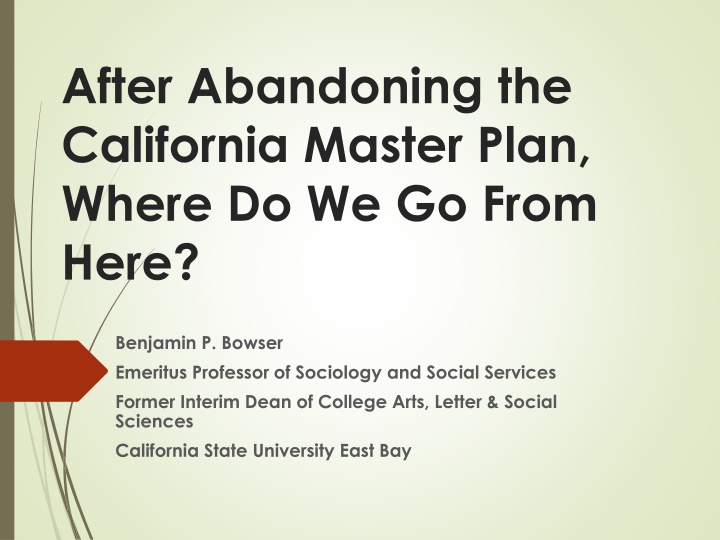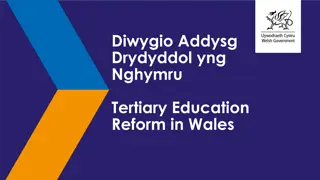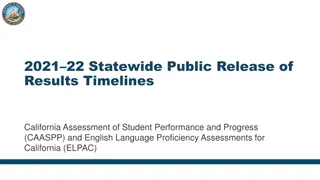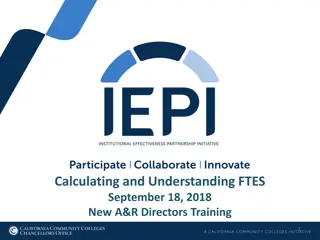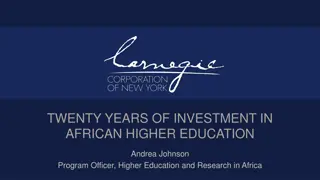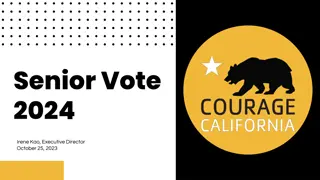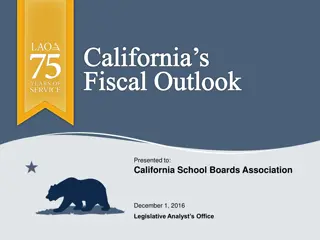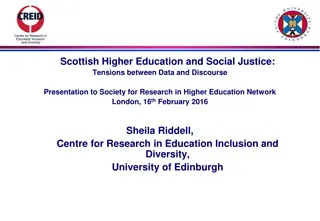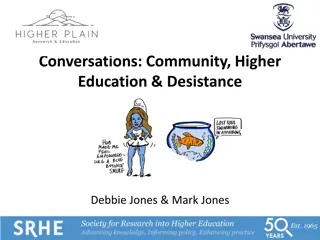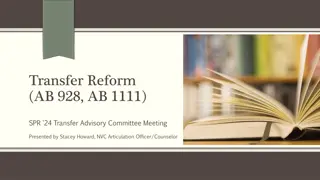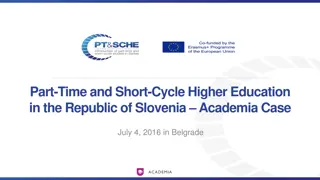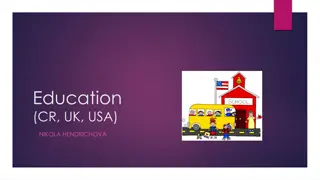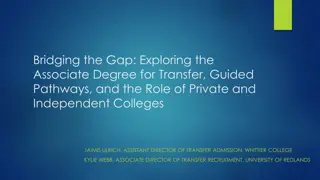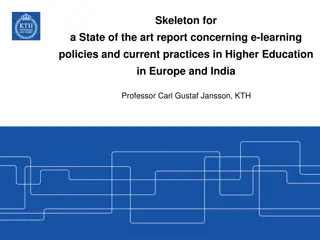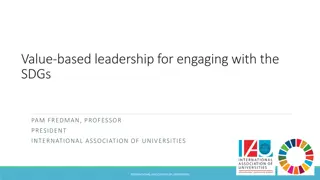Challenges and Future of California's Higher Education System
The California Master Plan for higher education has faced abandonment leading to significant changes in practices and funding over the years. The shift has impacted admissions, faculty quality, transfers between tiers, and remediation. Budgetary allocation trends and state general funds' proportion for higher education administration further highlight the challenges faced by the system.
Download Presentation

Please find below an Image/Link to download the presentation.
The content on the website is provided AS IS for your information and personal use only. It may not be sold, licensed, or shared on other websites without obtaining consent from the author.If you encounter any issues during the download, it is possible that the publisher has removed the file from their server.
You are allowed to download the files provided on this website for personal or commercial use, subject to the condition that they are used lawfully. All files are the property of their respective owners.
The content on the website is provided AS IS for your information and personal use only. It may not be sold, licensed, or shared on other websites without obtaining consent from the author.
E N D
Presentation Transcript
After Abandoning the California Master Plan, Where Do We Go From Here? Benjamin P. Bowser Emeritus Professor of Sociology and Social Services Former Interim Dean of College Arts, Letter & Social Sciences California State University East Bay
Based on Benjamin Bowser The Abandoned Mission in Public Higher Education: The Case of the California State University (New York: Routledge, 2017)
Chapter 2: The California Master Plan (1959) Increase access to high quality public higher education on three tiers Guaranteed admission for top 12% and 33% of state high school graduates. Regardless of financial status. University of California Graduate Degrees High quality faculty instruction. California State University Bachelor Degrees Competitive faculty pay and benefits. California Community Colleges/ Associates Degrees Liberal transfer between sectors. Remediation at Cal. Community Colleges. The California Master Plan updates: 1972, 1987 & 2002
Abandonment Specifics by 2019 Current Practices (2019) Original Plan (1959) Admissions not guaranteed Guaranteed admission top 1/3 Inc. tuition, loans & debt Financial barrier eliminated Decline in faculty / inc enrollments High quality faculty instruction Declining pay & benefits Competitive pay & benefits Declining transfers between tiers Liberal transfer between tiers Remediation at all three tiers Remedial in CCC
Budgetary Abandonment: California General Funds Expenditures by Function, 1967-2002 Legislature State & Judicial Executive Business Health Human Youth & Adult Public K-12 General Govern. Services Consumer Trans. Services Higher Educ TOTAL (%) Year Housing Resources Services Correction Educ 1967-68 1971-72 1975-76 1979-80 1983-84 1987-88 1991-92 1995-96 1998-99 2002-03 2.8% 2.7 2.2 1.8 2.0 2.4 3.7 3.2 3.2 3.2 1.5% 1.7 1.7 0.7 0.7 0.7 0.7 0.8 0.8 0.6 0.5% 0.3 0.4 0.7 0.2 0.2 0.4 0.7 0.7 0.4 2.4% 1.7 1.9 1.7 1.2 2.0 1.7 2.0 2.4 1.5 27.8% 33.1 30.1 31.6 31.5 31.2 31.6 31.4 27.9 28.2 4.0% 3.7 3.2 2.8 3.7 5.6 7.0 8.7 7.8 6.9 41.5% 16.8% 31.1 27.8 38.0 38.6 38.0 37.9 39.2 40.6 40.1 2.8% 9.1 15.9 7.4 7.9 4.5 3.5 1.9 4.0 6.3 100.0 100.0 100.0 100.0 100.0 100.0 100.0 100.0 100.0 100.0 16.6 16.8 15.2 14.1 15.4 13.5 12.2 12.7 12.7
California Higher Education Proportion of State General Funds By Year and Administration HE as % of all GF Year Govenor 1982 1983 1990 1991 1992 1993 2001 2002 2008 2011 16.26 14.44 15.84 14.55 12.55 12.14 15.39 14.62 12.72 11.91 Brown (D) Deukmejian (R) Deukmejian (R) Wilson (R ) Wilson (R ) Wilson (R ) Davis (D) Davis (D) Schwarzenegger (R ) Schwarzenegger (R ) Who is Responsible for Cuts?
California Higher Education Hierarchy & Decision-Making California Governor Decision-Making State Assembly H.E. Committee State Senate H.E. Committee UC Chancellor & Trustees CCC Chancellor & Trustees CSU Chancellor & Trustees Campus Administrations Campus Administrations Campus Administrations
Direct Effects of Budget Cuts Tuition increases. Not enough courses for the number of students enrolled. Pressure to cut major requirements. Increasing class sizes and online courses. More out of state and foreign students. Not enough faculty. Erosion of academic affairs. What is the real goal of budget cuts?
Endgame of Budget Cuts Public higher education is largest source of state revenue after health care still state managed ($7 billion/year in California alone). Eventual goal of budget cuts: Eliminate tenure and for institutions to welcome privatization. Privatization of public H.E. is a well articulated goal of some Republican Governors, legislators as well as the following foundations: The Bill and Melinda Gates Walton Kresge Lumina
Budget cuts have followed the current cohort of college students since their first grade Reasons for cuts Findings Budget decline as % of Gen. Fund Unsustained budget growth Boom/bust state budget Loss of public confidence H.E. is discretionary funding Fault of admin & faculty Poorly prepared students Composition of students Diversity of students Not an issue: pre-2002 recessions Not an issue prior to 2002 Has always been discretionary Unchanged Has been a problem since 1959 Became an issue after 1987 Became most evident after 2002 What is it about the new students?
California High School Graduates by Ethnicity, Statewide 1993, 2014 1993 2014 12th Grade 12th Grade Graduates % (N) % Graduates % (N) Change Asian 19 (1572) 18 (2426) -1 Hispanic 29 (2395) 32 (4356) 3 Afri-Am 21 (1685) 21 (2927) 0 White 31 (2525) 29 (3915) -2 Total 100(8177) 100(13614) 67
Where Do We Go From Here? Governor & Legislators Renew state higher education master planning. Return funding of higher education to 16% of State General Funds. Make Higher Education funding a mandatory budget line item as is primary and secondary education. Reinstate California Commission for Higher Education to coordinate relations between tiers, gather data, and evaluate outcomes. There is a need for greater transparency in budget formulation and decision-making. Independent audits of systems office and individual campuses.
Chancellors and Trustees (Do we need system-wide offices and trustees?) The chancellor should report to Presidents as trustees. Chancellor and Presidents should have ongoing means to learn the effects of decision-making from faculty and students. Reaffirm liberal arts as core of bachelor degrees in arts, science, education, business and technologies. Recalibrate per student costs. Campuses should know their budgets prior to the next fiscal years and receive funding promptly.
Campus Administration and Faculties (Keys to Great Universities) Administrations build their culture around serving faculty and students. The bottom line is the quality of what happens in the classroom (interactions between students & faculty). There is no substitute in a quality education for in-person interactions between student and faculty (low faculty- student ratio). Faculty driven curriculum and academic affairs. Chief administrators are selected from faculty with proven records of excellence in teaching and research, not career administrators.
Beach 2030 What is the meaning of no messages from Deans of College of the Arts and College of Liberal Arts? Messages make no reference to CSULB as part of a larger state system of H.E. with a Master Plan. Dean of College of Education is the only one to mention that CSULB is Hispanic, Asian and Native- American serving. Dean of Business Admin: Faculty & Admin. should work together, yet he questions concept of tenure? There is a distinct sense that a corporation could buy one of CSULB technical colleges?
Beach 2030 P-1 (Race/Ethnicity): State and County Population Projections by Race/Ethnicity: 2010-2060 Numeric and Percent Change 2010 to 2060 by Race/Ethnicity American Indian, not Hispanic or Latino Total (All race groups) White, not Hispanic or Latino Black, not Hispanic or Latino State/County Numeric 14,321,793 Percent 38% -1,988,944 Numeric Percent -13% Numeric 31,043 Percent Numeric 5,583 Percent California 1% 3% Los Angeles Orange Riverside San Bernardino 1,664,933 449,378 1,483,506 1,151,526 17% 15% 68% 56% -896,690 -410,790 -8,383 21,596 -33% -31% -1% 3% -134,190 2,187 61,855 62,029 -16% 5% 47% 36% -6,154 -1,735 10,982 -816 -32% -27% 99% -9%
Beach 2030 P-1 (Race/Ethnicity): State and County Population Projections by Race/Ethnicity: 2010-2060 Native Hawaiian and other Pacific Islander, not Asian, not Hispanic or Latino Multi-Race, not Hispanic or Latino State/County Hispanic or Latino Numeric 3,224,097 Percent 67% Numeric 89,646 Percent 67% 11,414,679 Numeric Percent 81% 1,545,689 Numeric Percent 168% California Los Angeles Orange Riverside San Bernardino 291,323 181,735 223,427 157,768 22% 34% 175% 126% 5,122 -75 16,076 1,773 22% -1% 267% 29% 2,174,923 543,963 1,077,750 818,572 46% 53% 108% 81% 230,599 134,093 101,799 90,604 127% 196% 223% 221%
Beach 2030 We must help create an informed public that recognizes its need for high quality low-cost public education.
